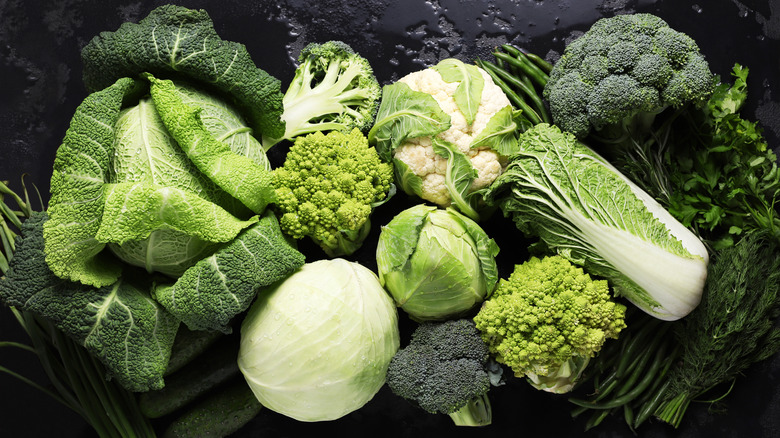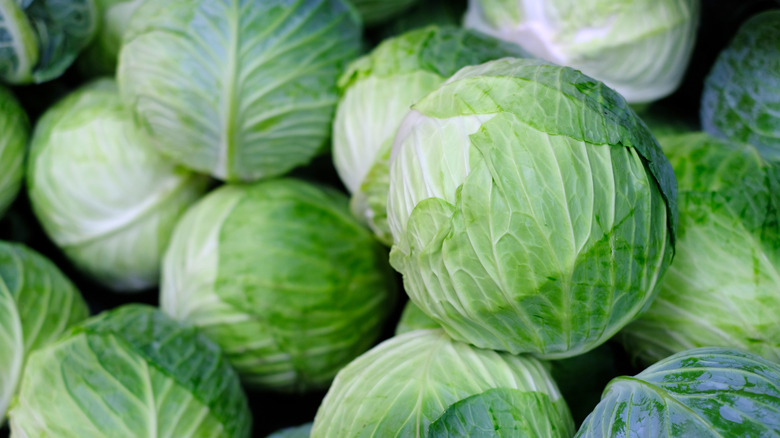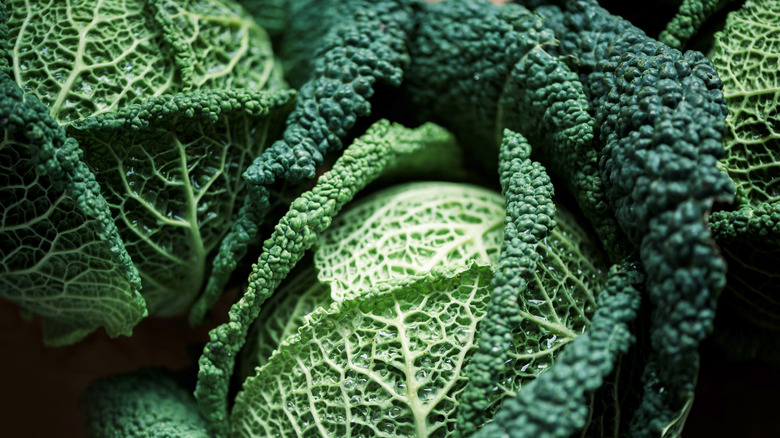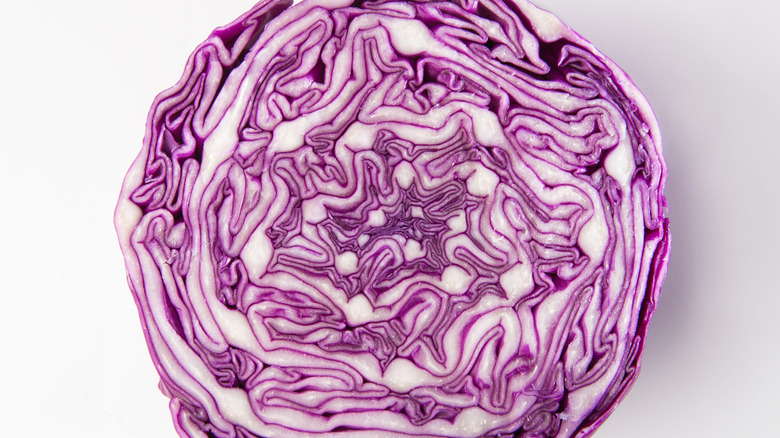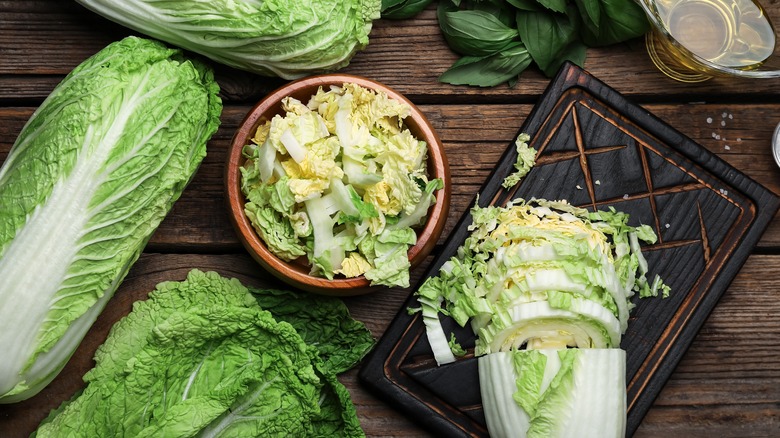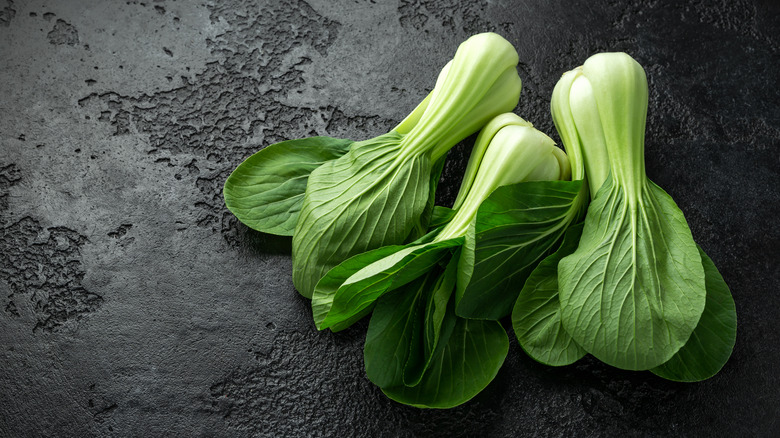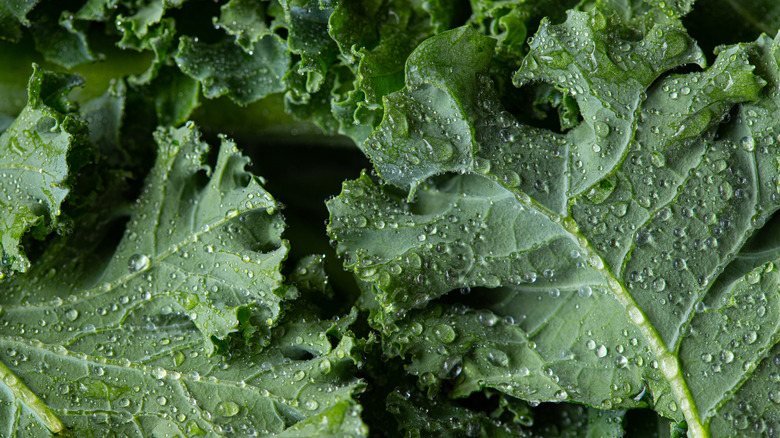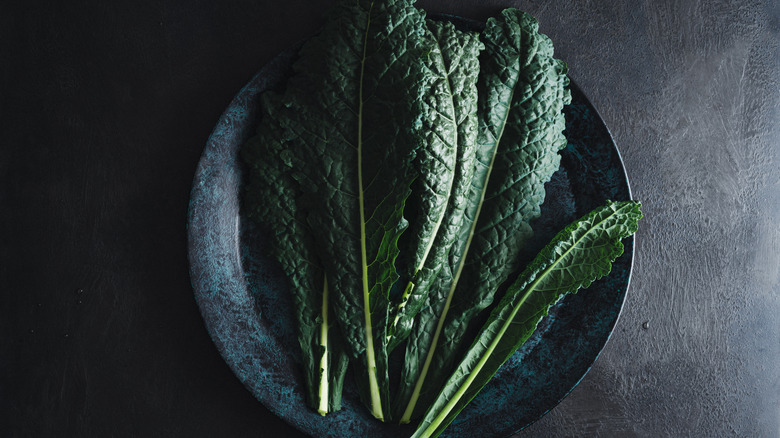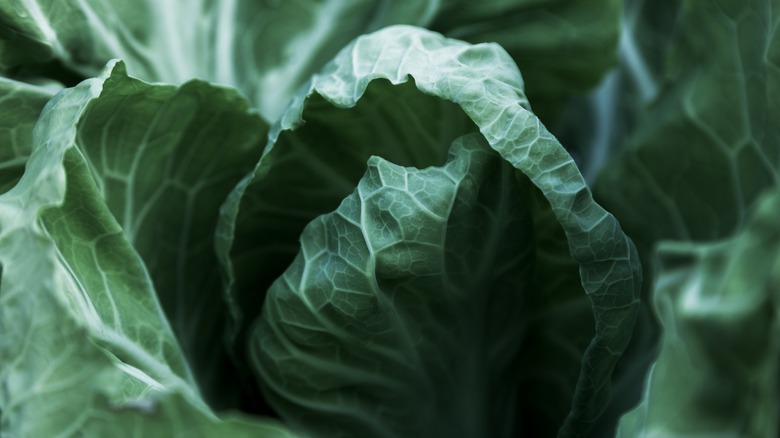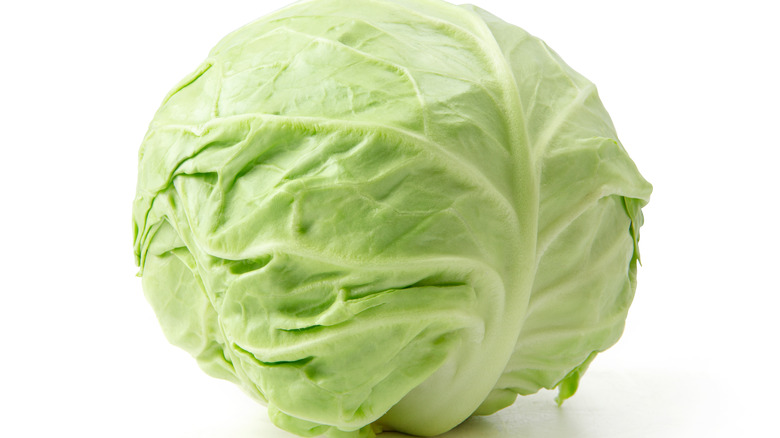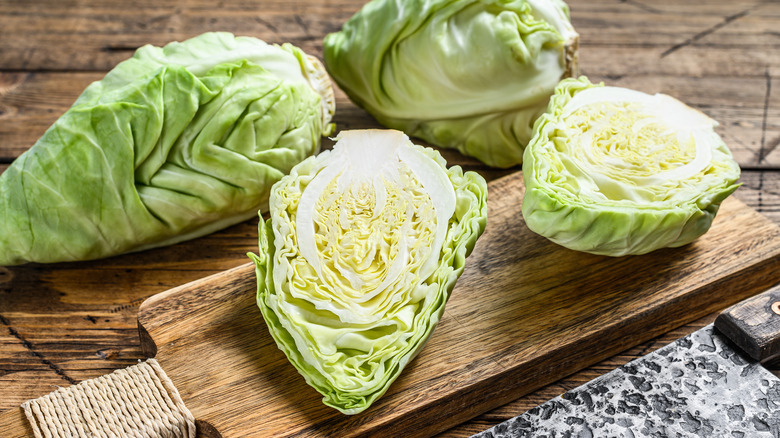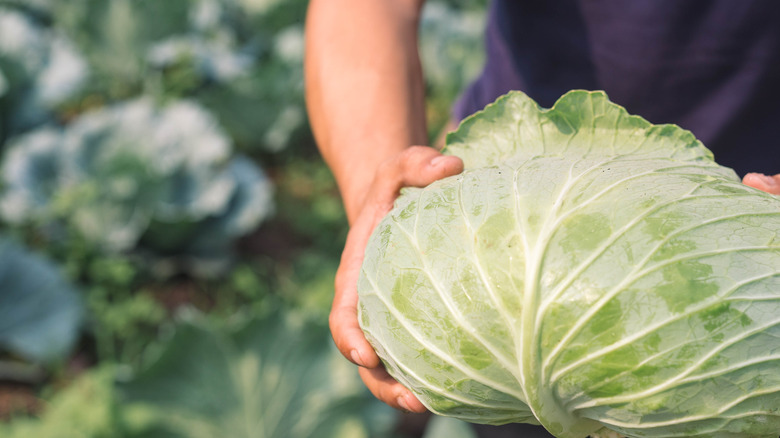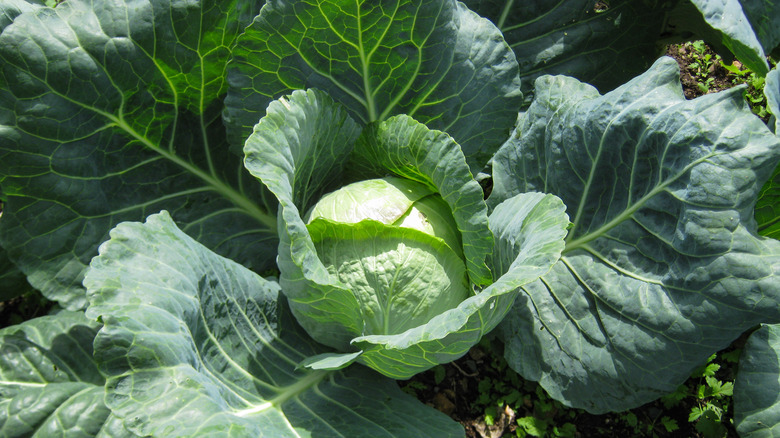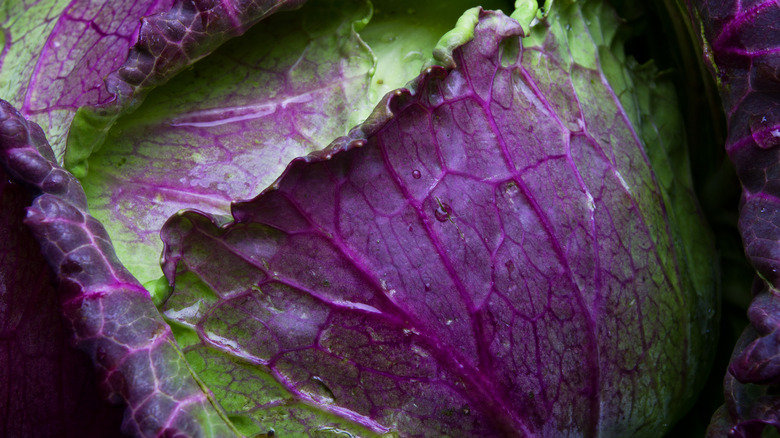14 Types Of Cabbage Varieties, Explained
One of the most overlooked and underrated vegetables in the market, cabbage has found its way into many dishes all across the world, whether it's kimchi, cabbage soup, or coleslaw. When you initially think of cabbage, the typical image of a tightly packed green bulb likely comes to mind. However, cabbage varieties range from the gem-like spheres of red cabbage to the long, elegant leaves of bok choy and even to the stunning purple and green watercolor scene painted on the leaves of a January King cabbage head.
The brassica vegetable family, which includes cabbage, comes in all shapes, colors, and sizes. Though they are sometimes grouped into the same family as lettuce and other leafy greens, cabbage is a cruciferous vegetable. This superfood is known for incredible health benefits, including a reduced risk of cancer and even increased functioning of the brain and nervous system. Scattered throughout the produce section of your favorite grocery stores or even in the soil of local gardens, these vegetables are vitamin powerhouses with a plethora of cooking methods to keep you full all year long! Here are a few of the several cabbage varieties and how to use them.
Green cabbage
Also known as "cannonball cabbage," this bright green bulb is perhaps the most well-recognized and familiar of all the cabbage siblings. Sturdy leafy greens that are appropriately balanced with bitter and sweet tastes provide a blank canvas for flavors. Green cabbage can be eaten raw, cooked, roasted, pickled, or even fermented. Often showcased in coleslaw, green cabbage can provide a crisp texture and bite to most dishes. Even the larger leaves can be used as wraps to create a healthier meal and take advantage of the high vitamin content and health benefits that green cabbage provides, according to Science Direct.
Known for its crunchy bite and mild flavor, green cabbage has been found to highlight many dishes in several cultures. These include okonomiyaki, a Japanese cabbage pancake in which finely chopped cabbage is combined with a mixture of pork, scallions, flour, and spices to create a savory explosion of balanced flavor.
Savoy cabbage
Competing as one of the largest in the cabbage family, the bulb of the savoy cabbage (sometimes referred to as "curly cabbage") is encircled by tough, crinkled, and loose leaves with a dark green hue. As you peel back the frilly layers of the savoy, coming closer to the bulb at the center of the vegetable, the leaves become softer and lean towards a light yellow shade. The savoy is versatile in its cooking and available throughout the year, showcasing a mild and muted sweet flavor.
Because of the thicker texture of the exterior savoy leaves, they don't need much time to cook and maintain their shape, unlike the lighter structure of the leaves that decorate the interior. According to Specialty Produce, savoy cabbage serves as an incredible source of fiber, potassium, and magnesium, as well as calcium, manganese, and iron. You can use the leaves as well as the core of the savoy cabbage to create a beautiful dish.
Red cabbage
Though we know it as "red cabbage," don't be fooled by the name. This type of cabbage appears as a bold, jewel-toned, deep purple in the produce section of your nearest grocery store. Red cabbage has a bit more of a peppery and bitter taste to its crunch, separating it from its milder, sweeter companions, such as green and white cabbage. Besides immense health benefits, such as increased bone health, digestive health, and heart health, red cabbage has found its way into a multitude of recipes all over the world.
Red cabbage is most commonly prepared raw to take advantage of the glorious purple color. However, take note that this stunning beauty can be eaten roasted, braised, grilled, or even fried. If cooking red cabbage, maintain its notable purple shade by adding a form of acid, such as vinegar or lemon. According to a study described in Science Direct, this will affect the anthocyanin in the cabbage and keep the color bright.
Napa cabbage
The word "napa" comes from regional Japanese. According to The Japan Times, napa (or nappa) translates to the "leaf vegetable" (it has no association with California's Napa Valley region). Napa cabbage is also popularly known as Chinese cabbage. Used in China since the 1200s, it wasn't used in Japan until the late 19th century. Since then, this cabbage variety has become popular all over the world, finding a home in various types of dishes and meals. Napa cabbage wouldn't be cabbage without a long list of health benefits and high nutritional value, including a large amount of vitamin B9, which improves the overall function of the heart and increases heart health.
The napa cabbage has a sweet, mellow taste and a crisp bite. Its thick white ribs and slightly tougher, elongated, light green leaves are easily recognizable. Napa cabbage is commonly found as the main ingredient in kimchi, and you'll often find it in broth-centered dishes. For a fresher variation, finely chop the napa cabbage leaves and combine them into a salad.
Bok choy
Native to the Yangtze River delta region in China, bok choy is a type of cabbage that has a mild yet bright and subtly sweet flavor. Almost sculptural, this vegetable appears as a long white bulb encircled with lengthened, elegant green leaves. Similar to its siblings in the cruciferous vegetable family, bok choy is packed full of vitamins and minerals, providing immense nutrients and health benefits. Bok choy is particularly high in vitamins C and K and, according to Healthline, may even contain properties that battle and prevent cancer.
The flavor of bok choy is dependent on which season throughout the year the vegetable is harvested. "The very young leaves of baby bok choy have a mild, lettuce-like flavor and are often sold with other members of the Chinese cabbage family as a salad mix. As bok choy reaches full maturity, its bitter flavors become more pronounced and mustardy, at which point it's excellent for steaming or sautéing." Keep these characteristics in mind, and you'll enjoy bok choy to its fullest year-round.
Kale
Kale is a variety of cabbage? It's true, according to the Farmers' Almanac. What is commonly known as the "headless cabbage," kale came to the rise as a health food hero. Kale has its own assortment of varieties, such as red Russian, Siberian, redbor, and winterbor, just to name a few. It come as an ornamental or a vegetable used year-long as the temperatures change the texture of the leaves. According to the Mayo Clinic, the high amounts of vitamins A, K, B6, and C are enough to entice someone to implement this hearty leaf into their diet. Still,l the versatility and flavor are enough to convert someone into a fan.
The uses for kale are endless, ranging from steaming or roasting to blending it into a smoothie or turning it into chips. You can also eat kale raw, though it is known for being extremely tough. If opting to eat it raw in a salad, take the time to gently massage the leaves with a bit of acid such as lemon juice, some salt, and perhaps an oil. This will break down the cell wall and remove some of the bitter flavors.
Tuscan cabbage
Also known as the "palm tree cabbage" or "Tuscan kale," Tuscan cabbage serves as a staple in Italy, specifically in the Tuscan region. More similar to its kale sibling, the dark green hues of the leaves often cause cultivators to refer to it also as "black kale." This dark — almost black — color owes its rich shade to the high content of chlorophyll found within the leaves. If you haven't yet heard the benefits of chlorophyll for the body, Medical News Today reports that chlorophyll may have anti-aging properties, increase oxygen flow to red blood cells, and help fight some types of cancer.
Versatile and easily prepared, Chef, restaurateur, and cookbook author Marco Canora makes use of Tuscan cabbage as a staple in an amaranth polenta dish. The Tuscan cabbage not only provides a bold color to any dish but also brings robust flavor to each bite.
Portugese cabbage
Throughout Europe, Portuguese cabbage is a favorite fixture in vegetable gardens. The leaves are high in vitamin C, iron, calcium, potassium, magnesium, and iron, making Portuguese cabbage another healthy addition to your dinner plate. According to a historical review published through Academia, this particular variety of cabbage has long been beloved by the people of Portugal. Notable ceramics designer Bordallo Pinheiro even created an entire line of intricate dishware dedicated to the art and architecture of the cabbage and the role it served in the country's cultural heritage.
Distinguished by dark green, oval-shaped leaves, and bright white stalks, the natural artistry of Portuguese cabbage makes it clear why Pinheiro selected them as the center point of his pottery collection. Portuguese cabbage makes a name for itself in traditional Portuguese hot stew dishes such as caldo verde, feijoada, and cozido à Portuguesa. Perfect for preparing as a meal for the colder seasons!
Mammoth red rock cabbage
A form of red cabbage that maintains a beautiful flavor and sweet taste. Mammoth red rock cabbage is in its prime time during the late-harvest season. Though this won't be available in every grocery store, if you happen to find it or try your hand at growing it at home, it will be well worth it. When cultivating mammoth red rock cabbage, patience is necessary because it takes 100 days for this variety to age to maturity. They grow rather large, reaching 8 pounds and 8 to 10 inches across the glorious purple-red core streaked with vibrant shades of green.
Often described with an intense peppery flavor, mammoth red rock cabbage is optimal for pickling to preserve and heighten the hearty flavor. You can brine finely chopped (or whole) mammoth red rock cabbage (or any other red cabbage) with ingredients like apple cider vinegar, garlic, sugar, coriander seeds, and black peppercorns.This quick version of pickled cabbage should be stored in a tightly sealed container in the refrigerator for an hour before eating and keeps well for a few weeks. Use it as a topping to a salad or main dish for a bright acidic bite. It's an easy, delicious way to add more color to any meal.
White cabbage
With immense versatility in its use, white cabbage is best known for its use in sauerkraut, and the tangy bite of fermented cabbage is most often associated with Germany. According to the New York Times, despite typical connections between sauerkraut and central European cuisine, sauerkraut (or an earlier form of fermented cabbage) first came from China rather than central Europe. No matter it's origin, there's sure to be plenty of sauerkraut to go around.
Recognized as a large white bulb of tightly packed leaves, despite its name, this cabbage turns a shade of green once the leaves are peeled back. It becomes even paler as the leaves are closer to the bulb and receive next-to-no sunlight. Sauerkraut isn't the only way to use white cabbage. Prepare for the cooler season and embrace Eastern European comfort food by trying out a cabbage roll soup recipe for your next cozy dinner, substituting the green cabbage for a bulb of white.
Pointed cabbage
The shape of the pointed cabbage is ... you guessed it ... pointed. It's a textured bulb of dark leaves with light green, nearly white, stalks that narrow to a point. But that's not all there is to this flavorful vegetable.
Pointed cabbage is a rich source of vitamins and contains so much vitamin C that, according to Healthline, simply one cup contains 54% of the daily recommended dietary intake (RDI). Full of dietary fiber and potassium, pointed cabbage is also known to support the immune system. Due to the crinkled texture of the leaves, pointed cabbage is easily digestible, protects the stomach and intestines, and aids in supporting gut health.
You can use pointed cabbage as a substitute for other varieties in recipes; some recommend shredding the leaves before cooking. They provide three ways to cook the pointed cabbage: blanching, frying it with chopped garlic, mixing, and wilting it into stew or risotto.
Green lunar
One of the cultivators of the green lunar cabbage, Takii, describes the green lunar cabbage as a hybrid variety. This cabbage appears somewhat flat in its shape with tightly packed bright green leaves. Harvest is recommended during the fall season, and the green lunar is resistant to cold climates and can flourish in harsher environments. Similar in flavor and construction to its extremely close relative, the green cannonball cabbage, the green lunar can be prepared similarly and used as a substitute for any recipe that calls for green cabbage.
Cook green lunar cabbage by sautéing it with shallots, garlic, olive oil, and sage leaves to create a healthy, robust dish. In a similar fashion, roasted cabbage wedges is a hearty side that makes good use of this variety. Simplicity is the star in that recipe as the thick slices of cabbage soak up the tangy marinade of olive oil, butter, lemon, and red pepper flakes bringing nothing short of a flavor bomb to your next dinner party.
Parel cabbage
The parel cabbage has a similar appearance to green cabbage, with slightly wrinkled green leaves that become lighter and nearly even a bright white as they come closer to the core of the vegetable. A Dutch hybrid, the parel cabbage does not produce its own seeds and needs to be manually planted and labored.
If you can't seem to find this cabbage variety in your nearest grocery store, growing it yourself is an option, though there will be effort required. This is well worth it, however, as an advantage of the parel cabbage is that it is highly weather tolerant and genetically resistant to various diseases and forms of rot. Even in very cold temperatures, the parel cabbage can continue to grow, which makes it extremely versatile for all climate conditions.
The leaves are tender and juicy once cooked with a mildly sweet flavor. Bring out the flavors of the parel cabbage by finely chopping the crisp leaves, sautéing them with garlic, and mixing them into a hearty winter stew.
January King cabbage
Standing out among other cabbage varieties, the January King cabbage is known for its extraordinary leaves. They appear as though an artistic watercolor masterpiece of green and purple hues has been painted individually onto each leaf. The January King has a similar rough, crinkled texture to the savoy cabbage and can be cooked by roasting or sautéing the leaves to draw out the sweet flavor.
Harvested in late winter, this cabbage is perfect for cold weather soups and stews. Due to its tough texture, it won't wilt as fast as other varieties of cabbage. If a stew isn't your style, take the liberty to combine the January King cabbage raw into a winter salad with herbs and other vegetables. The vibrant hues of this cabbage prove to be the star, beautifying every dish it touches. You can also use this vegetable as a garnish to decorate a plate and brighten it up with diverse colors.
